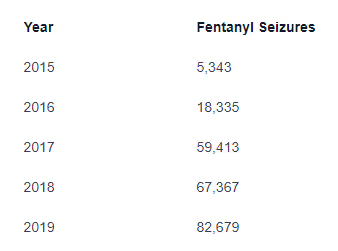Fentanyl and the U.S. Opioid Epidemic

Understanding the U.S. Opioid Epidemic
The U.S. is currently facing a severe opioid epidemic, which has had devastating consequences on individuals, families, and communities. To gain a comprehensive understanding of this crisis, it is important to delve into the overview of the opioid crisis, the factors contributing to its prevalence, and the impact it has had on society.
Overview of the Opioid Crisis
The opioid crisis refers to the widespread misuse and addiction to opioid drugs in the United States. Opioids are a class of drugs that include prescription painkillers such as oxycodone, hydrocodone, and morphine, as well as illicit substances like heroin. The crisis gained significant attention due to the alarming increase in opioid-related overdoses and deaths.
According to the Centers for Disease Control and Prevention (CDC), approximately 500,000 people died from opioid overdoses between 1999 and 2019. This crisis has had a profound impact on individuals, families, and communities across the nation.
Factors Contributing to the Epidemic
Several factors have contributed to the prevalence of the opioid epidemic in the United States. One major factor is the overprescription and misuse of prescription opioids. In the past, these medications were often prescribed for chronic pain management, leading to a higher risk of dependency and addiction.
Additionally, the illegal distribution and availability of opioids, including through online marketplaces, have further fueled the crisis. Some individuals turn to illicit opioids, such as heroin, as a cheaper and more accessible alternative to prescription drugs.
Impact on Society
The opioid epidemic has had a profound impact on society as a whole. It has strained healthcare systems, overwhelmed addiction treatment facilities, and placed a significant burden on law enforcement and public health agencies.
The consequences of the opioid crisis extend beyond the individual level, affecting families, communities, and the economy. Families have been torn apart by the loss of loved ones, and children have been left without parents or guardians. Communities have experienced increased crime rates, strained social services, and a decline in overall well-being.
The economic impact of the opioid epidemic is substantial. According to a report by the Council of Economic Advisers, the opioid crisis cost the United States over $2.5 trillion between 2015 and 2018. This includes healthcare expenses, lost productivity, and costs associated with criminal justice and social welfare programs.
Understanding the scope and impact of the U.S. opioid epidemic is crucial in addressing this crisis effectively. By examining the factors contributing to its prevalence and acknowledging the societal consequences, steps can be taken to mitigate the harm caused by this devastating public health issue.
Introduction to Fentanyl
Fentanyl plays a significant role in the ongoing opioid epidemic in the United States. To better understand its impact, it is important to explore what fentanyl is, its medical uses, and the illicit production and distribution associated with this potent synthetic opioid.
What is Fentanyl?
Fentanyl is a synthetic opioid that is classified as a Schedule II controlled substance due to its high potential for abuse and dependence. It is similar to other opioids, such as morphine and heroin, but is estimated to be 50 to 100 times more potent than morphine and 30 to 50 times more potent than heroin.
Medical Uses of Fentanyl
In a medical setting, fentanyl is primarily used for pain management, particularly for severe pain that is unresponsive to other medications. It is commonly administered through injection, transdermal patches, lozenges, or nasal sprays. These formulations allow for controlled and gradual release of the medication, ensuring effective pain relief.
Additionally, fentanyl is sometimes used during surgical procedures to induce anesthesia and maintain sedation. Its fast-acting and potent properties make it a valuable tool in managing acute pain in hospital settings.
Illicit Production and Distribution
Illicit production and distribution of fentanyl have contributed significantly to the opioid epidemic in the United States. Illicitly produced fentanyl is often created in clandestine laboratories, where its chemical structure is altered to produce analogs that can be even more potent than the original compound. These analogs are then mixed with other drugs, such as heroin or cocaine, without the knowledge or consent of the users.
Due to its high potency, fentanyl is often added to other drugs to increase their potency or to mimic their effects. This practice increases the risk of accidental overdose, as users may unknowingly consume a much stronger substance than they anticipated. Illicitly manufactured fentanyl and its analogs are frequently sold in powder form, as tablets, or disguised as other prescription medications.
Understanding the introduction and medical uses of fentanyl, as well as the illicit production and distribution associated with it, provides a foundation for comprehending its role in the U.S. opioid epidemic. The next section will delve into the increased presence of fentanyl in the illegal drug market, its potency and dangers, and the alarming rate of fentanyl-related overdose deaths.
Fentanyl's Role in the Opioid Epidemic
As the opioid epidemic continues to ravage the United States, one particular drug has played a significant role in exacerbating the crisis: fentanyl. This section explores the increased presence of fentanyl in the illegal drug market, its potency and dangers, and the devastating impact of fentanyl-related overdose deaths.
Increased Presence in the Illegal Drug Market
Fentanyl, a synthetic opioid that is up to 100 times more potent than morphine, has seen a dramatic rise in its presence within the illegal drug market. Illicitly manufactured fentanyl is often mixed with other drugs, such as heroin or cocaine, without the user's knowledge. This combination poses an extremely high risk of overdose, as users may unknowingly consume a lethal dose of fentanyl.
The chart below provides an overview of the increase in fentanyl-related seizures by law enforcement agencies in the United States from 2015 to 2019:

Potency and Dangers of Fentanyl
The potency of fentanyl is a major concern in the opioid epidemic. Even in small amounts, fentanyl can produce a powerful high, making it attractive to drug dealers looking to increase their profits. However, this high potency also makes fentanyl significantly more dangerous than other opioids. Users who are not accustomed to fentanyl or unaware of its presence in a drug they are consuming are at a heightened risk of overdose.
Fentanyl-related Overdose Deaths
Tragically, the increased presence and potency of fentanyl have led to a surge in fentanyl-related overdose deaths. The Centers for Disease Control and Prevention (CDC) reported that in 2019 alone, there were over 36,000 overdose deaths involving synthetic opioids, primarily fentanyl. This represents a staggering increase from previous years.
The following table illustrates the number of fentanyl-related overdose deaths in the United States from 2015 to 2019:

These numbers highlight the urgent need for effective interventions and strategies to address the fentanyl crisis and mitigate the devastating consequences it has on individuals, families, and communities across the nation.
While law enforcement efforts, harm reduction strategies, and treatment options are being implemented to combat the fentanyl epidemic, it is crucial to continue raising awareness, supporting research, and promoting evidence-based approaches to prevent further loss of lives to fentanyl-related overdoses.
Addressing the Fentanyl Crisis
As the fentanyl crisis continues to impact communities across the United States, various strategies and efforts have been implemented to address this alarming issue. Addressing the fentanyl crisis requires a multi-faceted approach, involving law enforcement efforts, harm reduction strategies, and treatment and rehabilitation options.
Law Enforcement Efforts
Law enforcement agencies play a crucial role in combating the fentanyl crisis. They work tirelessly to disrupt the production, distribution, and sale of illicit fentanyl. Efforts include targeting drug trafficking organizations, conducting investigations, and enforcing laws related to fentanyl and other dangerous substances.
Law enforcement agencies also collaborate with other stakeholders, such as intelligence agencies, international partners, and local communities, to gather information and enhance their ability to identify and apprehend individuals involved in fentanyl trafficking networks.
Harm Reduction Strategies
Harm reduction strategies aim to minimize the negative consequences associated with fentanyl use, particularly the risk of overdose and death. These strategies focus on providing education, resources, and support to individuals who use fentanyl or are at risk of fentanyl-related harm.
One key harm reduction strategy is the distribution of naloxone, a medication that can reverse the effects of an opioid overdose. Naloxone is often provided to individuals who use drugs, their friends, family members, and community organizations. Training programs are also conducted to ensure that individuals are equipped with the knowledge and skills to administer naloxone effectively.
Additionally, harm reduction efforts may include safe injection sites, where individuals can use substances under supervised conditions, reducing the risk of overdose and the transmission of infectious diseases. These sites often provide access to clean needles, counseling, and other support services.
Treatment and Rehabilitation Options
Addressing the fentanyl crisis requires a comprehensive approach to treatment and rehabilitation. Individuals struggling with fentanyl addiction need access to effective treatment options that address their physical, psychological, and social needs.
Treatment options for fentanyl addiction may include detoxification programs, inpatient or outpatient rehabilitation, counseling, and medication-assisted treatment (MAT). MAT involves the use of medications such as buprenorphine, methadone, or naltrexone, combined with counseling and behavioral therapies to support recovery.
Rehabilitation programs also focus on providing individuals with the necessary tools and support to overcome addiction, develop coping mechanisms, and reintegrate into society. These programs may offer individual and group counseling, vocational training, and assistance with housing and employment.
Addressing the fentanyl crisis requires a collaborative effort involving law enforcement, healthcare providers, community organizations, and individuals affected by fentanyl use. By combining law enforcement efforts, harm reduction strategies, and comprehensive treatment options, progress can be made in reducing the impact of fentanyl on individuals and communities.
Conclusion
The opioid epidemic in the United States is a complex issue that requires a multifaceted approach to address. The introduction of fentanyl into the illegal drug market has only exacerbated this crisis, leading to an alarming increase in overdose deaths and devastating consequences for individuals, families, and communities.
Efforts to combat the fentanyl crisis have included law enforcement action, harm reduction strategies, and comprehensive treatment options. While progress has been made, there is still much work to be done to prevent further loss of life and promote recovery from addiction.
By continuing to raise awareness about the dangers of fentanyl use, supporting evidence-based interventions and policies, and providing resources and support for affected individuals and communities, we can work towards mitigating the impact of this devastating public health issue. It is essential that we prioritize addressing the opioid epidemic and take action to prevent further harm caused by this crisis.
Sources:
- "The Opioid Epidemic in the United States." National Institute on Drug Abuse, 26 Jan. 2021, https://www.drugabuse.gov/drug-topics/opioids/opioid-overdose-crisis.
- Council of Economic Advisers. The Underestimated Cost of the Opioid Crisis. Executive Office of the President of the United States, Nov. 2017, https://www.whitehouse.gov/wp-content/uploads/2017/11/The-Economic-Cost-of-the-Opioid-Crisis.pdf.
- "Fentanyl." Centers for Disease Control and Prevention, 19 Oct. 2020, https://www.cdc.gov/drugoverdose/opioids/fentanyl.html.
